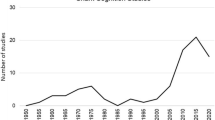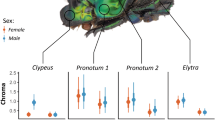Abstract
Few studies in non-mammalian vertebrates have examined how various effectors of the circadian system interact. To determine if the daily locomotor and behavioural thermoregulatory rhythms of Tiliqua rugosa are both controlled by the circadian system in different seasons, lizards were tested in laboratory thermal gradients in four seasons and in constant darkness. Circadian rhythmicity for both rhythms was present in each season, being most pronounced in spring and summer and least evident in autumn. Most lizards displayed a unimodal locomotor activity pattern across all seasons. However, some individuals presented a bimodal locomotor activity pattern in spring and summer. Seasonal variations in the phase relationships of both rhythms to the light:dark (LD) cycle were demonstrated. No seasonal differences in the free-running period lengths of either rhythm were detected, raising the possibility that a single circadian pacemaker drives both rhythms in this species. Our present results demonstrate that both rhythms are similarly controlled by the circadian system in each season. Although seasonal variations in the thermal preferences of reptiles both in the field and laboratory have previously been well documented, this study is the first to demonstrate circadian rhythms of temperature selection in a reptile species in each season.







Similar content being viewed by others
References
Avery RA (1980) Ecophysiology and behaviour of lacertid lizards—towards a synoptic model. Proc Euro Herp Symp CWLP, pp 71–73
Bennett A, John-Alder H (1986) Thermal relations of some Australian skinks (Sauria: Scincidae). Copeia 1986:57–64
Bertolucci C, Leorati M, Innocenti A, Foà A (1999) Circannual variations of lizard circadian activity rhythms in constant darkness. Behav Ecol Sociobiol 46:200–209
Bertolucci C, Sovrano A, Magnone MC, Foà A (2000) Role of suprachiasmatic nuclei in circadian and light-entrained behavioural rhythms of lizards. Am J Physiol 279:R2121–2131
Bertolucci C, Foà A, Van’t Hof TJ (2002) Seasonal variations in circadian rhythms of plasma melatonin in ruin lizards. Horm Behav 41:414–419
Beuchat CA (1988) Temperature effects during gestation in a viviparous lizard. J Thermal Biol 13:135–142
Beuchat CA (1989) Patterns and frequency of activity in a high altitude population of the Iguanid lizard, Sceloporus jarrovi. J Herpetol 23:152–158
Bourne AR, Taylor JL, Watson TG (1986) Effect of temperature on the seasonal production of testicular androgens, in vitro, by the lizard Tiliqua rugosa. Comp Biochem Physiol 85A:527–530
Bull CM, Main A, Dubas G (1991) Asynchronous seasonal activity of male and female sleepy lizards, Tiliqua rugosa. J Herpetol 25:436–441
Christian KA, Bedford GS (1995) Seasonal changes in thermoregulation by the frillneck lizard, Chlamydosaurus kingii, in tropical Australia. Ecology 76:124–132
Cowgell J, Underwood H (1979) Behavioural thermoregulation in lizards: a circadian rhythm. J Exp Zool 210:189–194
Daut EF, Andrews RM (1993) The effect of pregnancy on thermoregulatory behaviour of the viviparous lizard Chalcides ocellatus. J Herpetol 27:6–13
Dubas G, Bull CM (1991) Diet choice and food availability in the omnivorous lizard, Trachydosaurus rugosus. Wildl Res 18:147–155
Egan AJ, Firth BT, Breed WG (1984) Seasonal testicular cycle in the lizard Trachydosaurus rugosus. J Anat (Abstr) 143:236
Ellis DJ, Firth BT, Belan I (2006) Circadian rhythm of behavioural thermoregulation in the sleepy lizard (Tiliqua rugosa). Herpetologica 62:259–265
Ellis DJ, Firth BT, Belan I (2007) Circadian rhythms of locomotor activity and temperature selection in sleepy lizards, Tiliqua rugosa. J Comp Physiol A 193:695–701
Firth BT, Belan I (1998) Daily and seasonal rhythms in selected body temperatures in the Australian lizard Tiliqua rugosa (Scincidae): Field and laboratory observations. Physiol Zool 71:303–311
Firth BT, Kennaway DJ (1989) Thermoperiod and photoperiod interact to affect the phase of the plasma melatonin rhythm in the lizard Tiliqua rugosa. Neurosci Lett 106:125–130
Firth BT, Turner JS, Ralph CL (1989) Thermoregulatory behaviour in two species of iguanid lizards (Crotaphytus collaris and Sauromalus obesus): diel variation and the effect of pinealectomy. J Comp Physiol B 159:13–20
Firth BT, Kennaway DJ, Belan I (1991a) Thermoperiodic influences on plasma melatonin rhythms in the lizard Tiliqua rugosa: effect of thermophase duration. Neurosci Lett 81:1–13
Firth BT, Kennaway DJ, Belan I (1991b) Thermoperiodic factors regulating melatonin rhythms in lizards. Adv Pin Res 6:103–106
Firth BT, Belan I, Kennaway DJ, Moyer RW (1999) Thermocyclic entrainment of lizard blood plasma melatonin rhythms in constant and cyclic photic environments. Am J Physiol 277:R1620–R1626
Firth BT, Belan I, Kennaway DJ (2006) Persistence of a plasma melatonin rhythm in constant darkness and its inhibition by constant light in the sleepy lizard, Tiliqua rugosa. J Pineal Res 41:15–20
Foà A, Bertolucci C (2001) Temperature cycles induce a bimodal activity pattern in Ruin lizards: masking or clock-controlled event? A seasonal problem. J Biol Rhythms 16:574–584
Foà A, Bertolucci C (2003) Toward a seasonal model of the circadian system: the case of ruin lizards. Front Biosci 8:s236–s242
Foà A, Tosini G, Avery RA (1992) Seasonal and diel cycles of activity in the ruin lizard Podarcis sicula. Herpetol J 2:86–89
Foà A, Flamini M, Innocenti A, Minutini L, Monteforti G, Quaglieri C (1994) Seasonal changes of locomotor activity patterns in ruin lizards, Podarcis sicula. I. Endogenous control by the circadian system. Behav Ecol Sociobiol 34:267–274
Graham TE, Hutchison VH (1978) Locomotor activity in Chrysemys picta: response to asynchronous cycles of temperature and photoperiod. Copeia 1978:364–367
Grant BW, Dunham AE (1988) Thermally imposed time constraints on the activity of the desert lizard, Scleropus merriami. Ecology 69:167–176
Grenot C, Loirat F (1973) L′activité et le comportement thermorégulateur du lizard saharien Uromastix acanthinurus Bell. Terre et vie 27:435–455
Grenot C, Garcin L, Tséré-Pagès H (1996) Cold hardiness and behaviour of the European common lizard, Lacerta vivipara, from French populations during the winter. In: Geiser F, Hulbert AJ, Nicol SC (eds) Adaptations to the cold: 10th International hibernation symposium. University of New England, Armidale, pp 115–121
Huey RB, Pianka ER (1977) Seasonal variation in thermoregulatory behaviour and body temperature of diurnal Kalahari lizards. Ecology 58:1066–1075
Hutchinson M (1981) The systematic relationships of the genera Egernia and Tiliqua (Lacertilia: Scincidae): a review and immunological reassessment. In: Banks CB, Martin AA (eds) Proceedings of the Melbourne herpetological symposium. Board of Victoria, Melbourne, pp 176–203
Hutchison VH, Kosh RJ (1974) Thermoregulatory function of the parietal eye in the lizard Anolis carolinensis. Oecologia 16:173–177
Innocenti A, Foà A, Minutini L (1993) The pineal and circadian rhythms of temperature selection and locomotion in lizards. Physiol Behav 53:911–915
Janik DS, Menaker M (1990) Circadian locomotor rhythms in the desert iguana. I. The role of the eyes and the pineal. J Comp Physiol A 166:803–810
Janik DS, Pickard GE, Menaker M (1990) Circadian locomotor rhythms in the desert iguana. II. Effects of electrolytic lesions to the hypothalamus. J Comp Physiol A 166:811–816
Jarling C, Bleichert A, Scarperi M (1989) Circadian rhythm in the temperature preference of the turtle, Chrysemys scripta elegans, in a thermal gradient. J Therm Biol 14:173–178
Kerr GD, Bull CM (2006) Movement patterns in the monogamous sleepy lizard (Tiliqua rugosa): effects of gender, drought, time of year and time of day. J Zool 269:137–147
Kerr GD, Bull CM, Cottrell GR (2004) Use of an ‘onboard’ data logger to determine lizard activity patterns, body temperature and microhabitat use for extended periods in the field. Wildl Res 31:171–176
Ladyman M, Bradshaw D (2003) The influence of dehydration on the thermal preferences of the Western tiger snake, Notechis scutatus. J Comp Physiol B 173:239–246
Licht P (1966) Reproduction in lizards: influence of temperature on photoperiodism in testicular recrudescence. Science 154:1668–1670
Licht P, Dawson WR, Shoemaker VH, Main AR (1966) Observations on the thermal relations of Western Australian lizards. Copeia 1966:97–110
MacMillen RE, Augee ML, Ellis B (1989) Thermal ecology and diet of some xerophilous lizards from western New South Wales. J Arid Environ 16:193–201
Magnone MC, Jacobmeier B, Bertolucci C, Foà A, Albrecht U (2005) Circadian expression of the clock gene Per2 is altered in the ruin lizard (Podarcis sicula) when temperature changes. Mol Brain Res 133:281–285
Melville J, Swain R (1997) Daily and seasonal activity patterns in two species of high altitude skink, Niveoscincus microlepidotus and N. metallicus, from Tasmania. J Herpetol 31:29–37
Miranda-Anaya M, Bartell P, Yamasaki S, Menaker M (2000) Circadian rhythm of ERG in Iguana iguana: role of the pineal. J Biol Rhythms 15:163–171
Molina-Borja M (1996) Pineal gland and circadian locomotor activity rhythm in the lacertid Gallotia galloti eisentrauti: pinealectomy induces arrhythmicity. Biol Rhythm Res 27:1–11
Ouboter PE (1981) The ecology of the island-lizard Podarcis sicula salfii: Correlation of microdistribution with vegetation coverage, thermal environment and food-size. Amphibia-Reptilia 2:243–257
Paulissen MA (1988) Ontogenetic and seasonal comparisons of daily activity patterns of the six-lined racerunner, Cnemidophorus sexlineatus (Sauria: Teiidae). Am Midland Nat 120:355–361
Pittendrigh CS, Daan S (1976a) A functional analysis of circadian pacemaker in nocturnal rodents. I. The stability and lability of spontaneous frequency. J Comp Physiol 106:223–252
Pittendrigh CS, Daan S (1976b) A functional analysis of circadian pacemaker in nocturnal rodents. V. Pacemaker structure: a clock for all seasons. J Comp Physiol 106:333–355
Refinetti R (1992) Non-parametric procedures for the determination of phase markers of circadian rhythms. Int J Biomed Comp 30:49–56
Refinetti R, Susalka SJ (1997) Circadian rhythm of temperature selection in a nocturnal lizard. Physiol Behav 62:331–336
Regal PJ (1967) Voluntary hypothermia in reptiles. Science 155:1551–1553
Revel FG, Herwig A, Garidou M-L, Dardente H, Menet JS, Masson-Pévet M, Simmoneaux V, Saboureau M, Pévet P (2007) The circadian clock stops ticking during deep hibernation in the European hamster. Proc Nat Acad Sci USA 104:13816–13820
Rismiller PD, Heldmaier G (1982) The effect of photoperiod on temperature selection in the European green lizard. Oecologia 53:222–226
Rismiller PD, Heldmaier G (1988) How photoperiod influences body temperature selection in the lizard Lacerta viridis. Oecologia 75:125–131
Rock J, Cree A, Andrews RM (2002) The effect of reproductive condition on thermoregulation in a viviparous gecko from a cool climate. J Therm Biol 27:17–27
Schäuble CS, Grigg GC (1998) Thermal ecology of the Australian agamid lizard Pogona barbata. Oecologia 114:461–471
Shine R, Lambeck R (1990) Seasonal shifts in the thermoregulatory behaviour of Australian blacksnakes, Pseudechis porphyriacus (Serpentes: Elapidae). J Therm Biol 15:301–305
Sokolove PG, Bushell WN (1978) The chi-square periodogram: its utility for analysis of circadian rhythms. J Theor Biol 72:131–160
Tosini G, Menaker M (1995) Circadian rhythm of body temperature in an ectotherm (Iguana iguana). J Biol Rhythms 10:248–255
Tosini G, Menaker M (1996) The pineal complex and melatonin affect the expression of the daily rhythm of behavioural thermoregulation in the green iguana. J Comp Physiol A 179:135–142
Tosini G, Menaker M (1998) Multioscillatory circadian organization in a vertebrate, Iguana iguana. J Neurosci 18:1105–1114
Tosini G, Bertolucci C, Foà A (2001) The circadian system of reptiles: a multioscillatory and multiphotoreceptive system. Physiol Behav 72:461–471
Underwood H (1977) Circadian organization in lizards: the role of the pineal organ. Science 195:587–589
Underwood H (1983) Circadian organization in the lizard Anolis carolinensis: a multioscillatory system. J Comp Physiol 152:265–274
Underwood H (1992) Endogenous Rhythms. In: Gans C, Crews D (eds) Biology of the Reptilia: hormones, brain and behaviour, vol 18. University of Chicago Press, Chicago, IL, pp 229–297
Underwood H, Wassmer GT, Page TL (1997) Daily and seasonal rhythms. In: Dantzler WH (ed) Handbook of physiology, Sect. 13, vol 2. Oxford University Press, New York, pp 1653–1763
Warburg MR (1965) The influence of ambient temperature and humidity on the body temperature and water loss from two Australian lizards, Tiliqua rugosa Gray (Scincidae) and Amphibolurus barbatus Cuvier (Agamidae). Aust J Zool 13:331–350
Acknowledgments
This research project was supported by the Faculty of Health Sciences at the University of Adelaide and a Faculty of Health Sciences Postgraduate Research Scholarship to David Ellis. The research was approved by the University of Adelaide Animal Ethics Committee (M/79/2004) and the South Australian Department of Environment and Heritage (Z24971_1 and Z24971_2).
Author information
Authors and Affiliations
Corresponding author
Rights and permissions
About this article
Cite this article
Ellis, D.J., Firth, B.T. & Belan, I. Interseasonal variation in the circadian rhythms of locomotor activity and temperature selection in sleepy lizards, Tiliqua rugosa . J Comp Physiol A 194, 701–712 (2008). https://doi.org/10.1007/s00359-008-0341-3
Received:
Revised:
Accepted:
Published:
Issue Date:
DOI: https://doi.org/10.1007/s00359-008-0341-3




